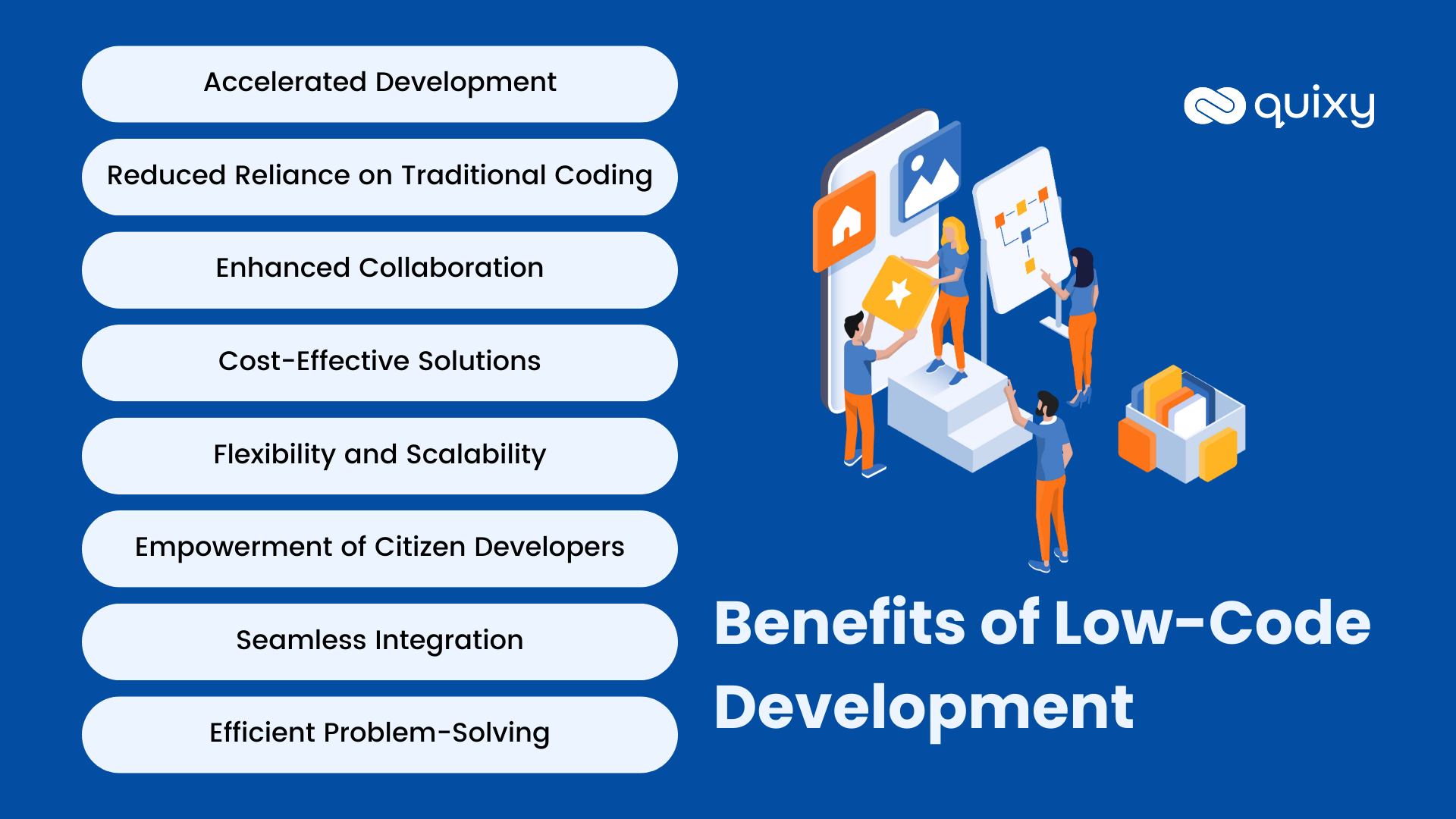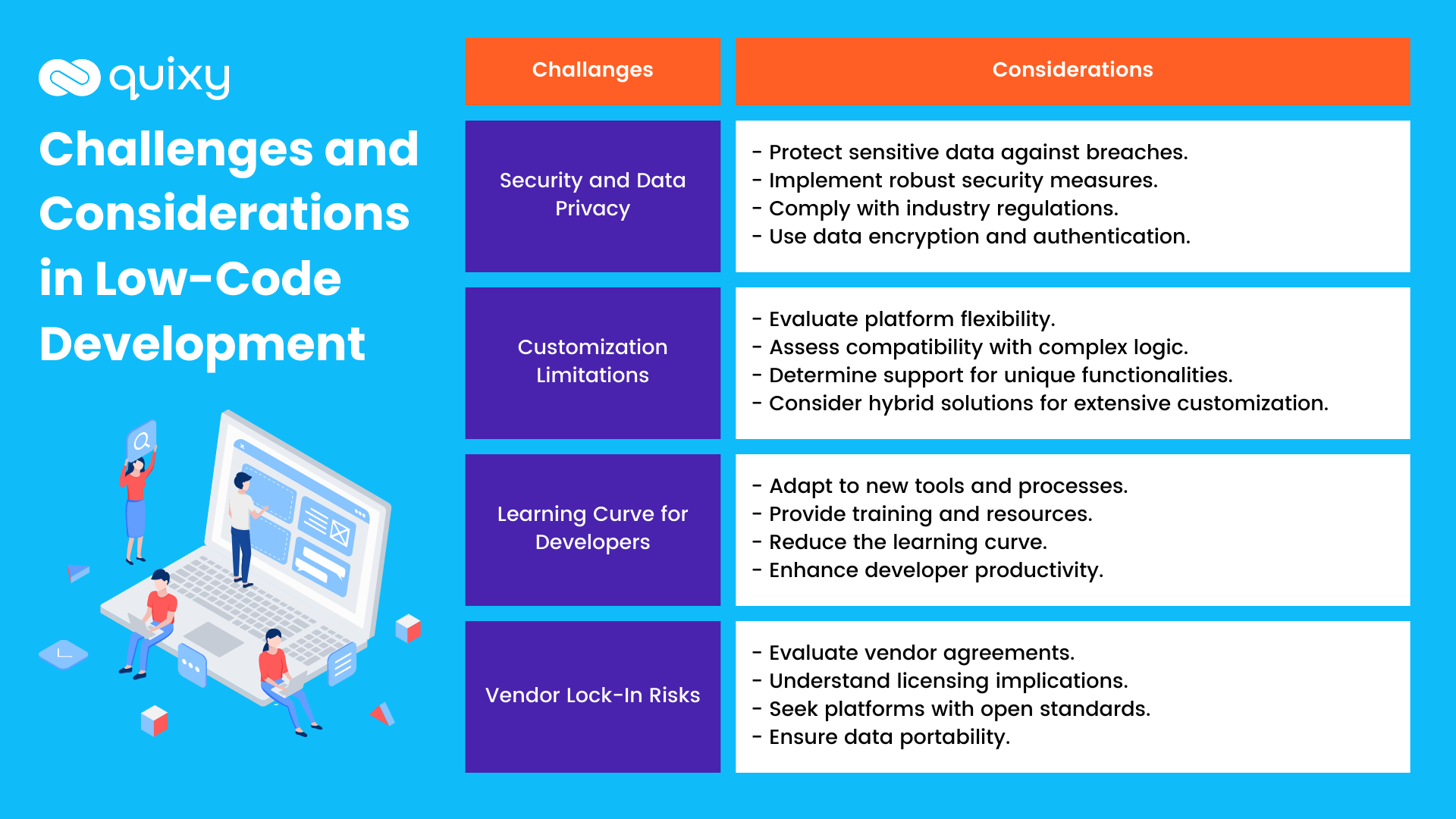
Low-code software development is the next big thing in the tech industry. This thought provokes dozens of questions: what exactly is low-code, why is it trending, does it affect my business, and is there any future scope? We are sure you, as a software developer, must have a lot more questions.
Considering that low-code development is revolutionizing and promoting citizen development, it is crucial for you to be aware and have answers to all those questions your mind is asking.
So, in this article, we will demystify low-code — from its meaning and importance to low-code challenges and future trends. Once you are done reading, we are sure your mind will be at ease. So let’s begin:
What is Low-Code Development?
Low-code development refers to a software development approach that allows individuals to create applications with minimal hand-coding. It utilizes visual interfaces, pre-built components, and drag-and-drop functionality to streamline and accelerate the application development process. LCNC platforms enable developers, including those with limited coding experience, to design, develop, and deploy applications quickly, reducing the traditional complexities of coding and increasing overall efficiency.
Low code development is a visual approach to software creation that minimizes traditional hand coding. Low code platforms provide drag and drop interfaces and prebuilt components to accelerate low code application development while still allowing customization through pro code extensions when needed.
Key characteristics of low code technology include:
- Visual development interfaces for low code web development and low code mobile app development
- Prebuilt templates and modules for faster low code software development
- Integration capabilities for low code business solutions
- Scalable low code architecture for enterprise applications
Low-Code vs. No-Code
LCNC are two related but distinct approaches to application development. Here is the basic difference between low-code and no-code.
- Low-Code: In LC development, some level of coding is involved, but it is significantly simplified compared to traditional coding methods. Developers use visual interfaces and pre-built components to create applications faster and more intuitively.
- No-Code: No-code development involves creating applications without writing any code. Instead, users leverage visual tools and pre-configured components to assemble applications. This approach is ideal for users with little to no coding experience, as it eliminates the need for manual coding entirely.
No code platforms take simplification further by enabling non technical users (citizen developers) to create applications without any coding knowledge. These no code tools are ideal for:
- Simple workflow automation
- Basic app prototypes
- Departmental solutions
- Rapid no code low code platforms implementations
The main difference between no code vs low code lies in customization capabilities – low code systems allow more technical flexibility while no code platforms prioritize ease of use.
Low-code involves some level of coding with simplified tools, while no code requires no coding at all and focuses on visual composition and configuration. Both approaches aim to increase development speed and accessibility for a wider range of users.
Also Read: No-Code Vs. Low-Code: Breaking down the Pros and Cons
Who can use Low-Code Development?
Low-code platforms provide a collaborative environment where professional developers and citizen developers can leverage their respective strengths to create effective and efficient applications.
Professional Developers
Professional developers can harness low-code platforms as powerful tools to streamline their development process. They can leverage pre-built components and visual interfaces to accelerate the creation of basic features and functionalities. This allows them to allocate more time and effort to solving intricate coding challenges, ensuring the application’s performance and security. Additionally, professional developers can collaborate more effectively with business stakeholders, aligning the development process with specific business needs.
Also Read: Master Blockchain Applications and DApps: A Developer’s Handbook
Citizen Developers
Citizen developers, even without extensive coding experience, can actively contribute to through low-code platforms. The intuitive drag-and-drop interfaces enable them to create user interfaces, define workflows, and set up basic logic without delving into complex coding. This empowers individuals from various departments to address specific business needs swiftly. However, while citizen developers can handle many aspects of development, collaboration with professional developers ensures the creation of robust and scalable applications.
Also Read: Innovating with Ease: How Visual Programming Transforms Software Development?
What are the Benefits of Low-Code Development for Enterprise?
Low-code development has emerged as a transformative solution, revolutionizing the software development landscape. Let’s delve into the benefits of low-code that make low-code the preferred choice for modern enterprises.

Low-code development holds immense importance in modern software development due to its transformative impact on various aspects of the industry. Here are some key reasons why low-code development is becoming increasingly crucial:
Accelerated Time-to-Market
Low-code platforms enable rapid application development through intuitive visual interfaces and pre-built components. This speed allows businesses to respond swiftly to market demands, launching new software solutions in a fraction of the time it would take with traditional coding methods.
Enhanced Collaboration
Low-code platforms bridge the gap between IT and business teams by providing a common ground for communication. Business users can actively participate in the development process, sharing their insights and requirements directly with developers, leading to more aligned and efficient development cycles.
Increased Productivity
With reduced manual coding, developers can focus on solving complex problems and designing innovative features rather than dealing with repetitive tasks. This boosts overall team productivity and empowers developers to deliver high-quality applications.
Cost-effectiveness
By streamlining the development process and eliminating the need for extensive coding expertise, low-code development significantly reduces project costs. Smaller businesses, in particular, can leverage this technology to create custom applications without the need for a large development team.
Flexibility and Scalability
Low-code platforms allow for iterative development, enabling developers to continuously enhance and scale applications as business needs evolve. This adaptability ensures that software remains relevant and up-to-date in a rapidly changing technological landscape.
Empowering Citizen Developers
Low-code development empowers individuals without extensive coding experience, known as citizen developers, to contribute to application creation. This democratization of development opens up new opportunities for innovation and creativity across the organization.
Integration Capabilities
Low-code platforms often come with built-in connectors and integration capabilities, making it easier to connect with existing systems and third-party applications. This fosters seamless data exchange and interoperability within an organization’s technology ecosystem.
Also Read: 5 ways to achieve Success with No-Code Low-Code
Increased Speed of Development
Time is of the essence in today’s digital world. Low-code platforms empower developers with intuitive visual interfaces and pre-built components, drastically expediting the application development process. By cutting down coding complexities, businesses can now launch innovative software solutions at unprecedented speed, gaining a valuable edge in the market.
Reduced Reliance on Traditional Coding
With drag-and-drop functionalities and visual tools, the barriers to entry are lowered, inviting citizen developers and non-coders to actively contribute to the development process. This democratization of technology unleashes creativity from diverse sources, driving innovation and fostering a collaborative development environment.
How Low-Code is Different from Traditional Development
Low-code development stands out as a superior approach in many ways, particularly for businesses seeking speed, accessibility, and cost efficiency. It enables rapid development and deployment, allowing organizations to bring solutions to market much faster than traditional methods. With its user-friendly, drag-and-drop interfaces, low-code platforms are accessible to non-technical users, empowering teams across departments to contribute to app development. This fosters better collaboration between technical and non-technical teams, streamlining workflows and reducing dependency on skilled developers.
Low-code solutions are cost-effective, with lower initial development costs and simplified maintenance due to built-in tools and updates. While traditional development offers unmatched customization for highly complex systems, low-code excels in delivering quick, scalable, and efficient solutions for most business needs, making it the preferred choice for modern, agile organizations.
Who are the Low-Code Developers?
Low-code developers are individuals who use low-code development platforms to create applications with minimal hand-coding. These platforms provide visual interfaces, drag-and-drop tools, and pre-built templates, enabling users to design, build, and deploy applications more quickly and with less technical expertise compared to traditional software development.
Key Characteristics of Low-Code Developers
- Diverse Backgrounds: They may come from non-traditional coding backgrounds, such as business analysts, project managers, or domain experts, rather than being professional programmers.
- Focus on Speed: They prioritize rapid application development and iterative processes to meet business needs quickly.
- Limited Coding Knowledge: While they may have some understanding of programming concepts, they rely heavily on the platform’s visual tools and pre-built components.
- Problem-Solving Skills: They excel at understanding business requirements and translating them into functional applications.
- Collaborative Role: They often work alongside professional developers, IT teams, and stakeholders to deliver solutions
What Are Low-Code Platforms?
Low-code platforms are development environments that allow users to create applications with minimal manual coding. They provide a visual interface, often involving drag-and-drop components, pre-built templates, and reusable code modules. These platforms are designed to simplify the development process, enabling both technical and non-technical users (also known as “citizen developers”) to build, test, and deploy applications efficiently.
By reducing the complexity of traditional coding, low-code platforms empower organizations to:
- Accelerate Development: Deliver applications faster, reducing time-to-market.
- Enhance Collaboration: Bridge the gap between IT and business teams.
- Lower Costs: Minimize reliance on specialized developers.
- Drive Innovation: Enable rapid prototyping and iteration.
Whether it’s automating workflows, creating customer-facing applications, or modernizing legacy systems, low-code platforms are transforming how businesses innovate and adapt to changing needs.
Also Read : Why User-Centric Design is A Key to Successful Products
What are the key features of Low-code development platforms?
LCNC application development strategy platforms, offer several key features that enable users to create applications quickly and efficiently:
Drag and Drop Interface
These platforms offer a user-friendly interface allowing developers and citizen developers to build applications by dragging and dropping elements, such as widgets, forms, and modules. This intuitive approach eliminates the need for extensive manual coding, speeding up the development process.
Visual Modeling Tools
The development platforms provide visual modeling tools that enable users to design application workflows, data models, and user interfaces graphically. This visual representation simplifies the design process and enhances communication between stakeholders.
Built-In Integration with Existing Systems
These platforms come with pre-built connectors and APIs that facilitate seamless integration with various external systems and data sources. This feature enables developers to connect their applications with existing databases, cloud services, and third-party software, ensuring efficient data exchange.
Workflow Automation Capabilities
These platforms offer workflow no-code low-code automation features, allowing developers to define and automate business processes easily. These capabilities streamline repetitive tasks, improve operational efficiency, and enhance user experiences.
Mobile App Development Support
With the growing demand for mobile applications, low-code platforms often provide specialized tools and templates for building mobile apps. This support enables developers to create cross-platform applications that run smoothly on different devices and operating systems.
Also Read: The Future of Software is No-Code and Low-Code Programming
Essential Features of Low Code Tools
When evaluating low code development tools, look for these key low code features:
- Visual Modeling: Drag and drop interfaces for low code dev
- Workflow Automation: Create low code automation platforms
- Mobile Support: Build low code app development platform solutions
- AI Capabilities: Smart suggestions in advanced low code dev platforms
- Security: Enterprise grade protections in low code environment setups
Key Benefits of Low Code Platforms
Modern low code development platforms offer numerous advantages:
- Speed & Efficiency: Accelerate low code app development by 5-10x compared to traditional coding
- Cost Reduction: Lower development costs with low code solutions
- Business Agility: Enable citizen development across departments
- Scalability: Enterprise grade low code application platforms can grow with your needs
- Integration: Built in connectors for seamless low code integration
Leading platforms like Quixy low code platform demonstrate these low code platform benefits for organizations of all sizes.
What are the use cases of Low-code development?
The versatility of LCNC development caters to diverse use cases across industries due to its ability to quickly create solutions without extensive coding. Some common use cases include:
Rapid Prototyping and Proof of Concept Development
Low-code development platforms excel at quickly building prototypes and proof of concept (POC) applications. Businesses can use these prototypes to demonstrate ideas, gather feedback, and validate concepts before committing significant resources to full-scale development. The agility and ease of use provided by these platforms make them ideal for iterating and refining early-stage projects.
Legacy System Modernization
Updating outdated legacy systems can be a complex and time-consuming process. Low-code development offers a practical solution by enabling organizations to modernize their legacy systems without completely rebuilding them. Developers can integrate modern features and functionalities into existing applications, extending the lifespan of legacy systems and improving their overall performance.
Citizen Development and Citizen Developer Empowerment
Low-code platforms empower non-technical users, also known as citizen developers, to participate in application development. By providing a user-friendly interface and abstracting complex coding, these platforms enable individuals from various departments to contribute to the creation of customized applications that address their specific needs. This democratization of development promotes innovation and efficiency within the organization.
Enterprise Application Development
The low-code development is highly advantageous for creating complex and scalable enterprise applications. Businesses can build a wide range of applications, such as CRM systems, project management tools, human resources portals, and more, to enhance internal processes and streamline operations. The rapid development capabilities and integration features of low-code platforms make them a valuable asset for enterprises seeking to stay competitive and adaptable in a dynamic market.
Also Read: Rapid App Development with Quixy, Experience the Revolutionary Power
Top Use Cases for Low Code/No Code
- Enterprise Applications: CRMs, ERMs built on low code application platforms
- Process Automation: Workflow solutions using low code business solutions
- Legacy Modernization: Updating old systems with low code technology
- Departmental Tools: HR, finance apps created by citizen developers
- Prototyping: Rapid low code dev for proof of concepts
Examples of Low-Code Solutions
| Category | Use Case |
|---|---|
| Business Process Automation | Automating workflows like employee onboarding, approvals, or invoice processing. |
| Customer Relationship Management (CRM) | Tracking customer interactions, managing leads, and automating follow-ups. |
| Mobile App Development | Building mobile apps for internal use or customer-facing purposes. |
| Data Collection and Reporting | Creating forms for data collection and generating real-time reports. |
| E-Commerce Applications | Developing online stores with integrated payment and inventory management. |
| Internal Tools and Portals | Building employee portals, help desks, or project management tools. |
| IoT and Smart Device Integration | Monitoring and controlling IoT devices for real-time insights. |
| Healthcare Solutions | Managing patient records, appointments, or telehealth services. |
| Education and Training Platforms | Delivering e-learning courses and tracking student progress. |
| Event Management | Managing event registrations, ticketing, and attendee engagement. |
| Financial Applications | Creating budgeting tools, expense trackers, or loan management systems. |
| Real Estate Solutions | Developing property management systems or tenant portals. |
| Non-Profit and Community Platforms | Managing donations, volunteers, or community engagement. |
| Supply Chain and Logistics | Tracking inventory, shipments, or supplier interactions. |
| Custom Dashboards and Analytics | Building interactive dashboards for data visualization and insights. |
What are the challenges and considerations in low-code development?

While the development offers many benefits, there are also several low-code challenges and considerations to keep in mind:
Security and Data Privacy Concerns
One of the primary concerns in the LC development is ensuring the security and privacy of sensitive data. With rapid application development, it is crucial to implement robust security measures to protect against data breaches and unauthorized access. These platforms must comply with industry standards and regulations, and developers should follow best data encryption and authentication practices to maintain data integrity.
Customization Limitations
While LCNC platforms offer great flexibility, they may have certain customization limitations. Organizations need to evaluate their specific requirements and determine whether the platform can accommodate complex business logic or unique functionalities. In cases where extensive customization is essential, hybrid approaches that combine low-code and traditional development methods may be necessary.
Learning Curve for Developers
Adopting low-code development might require developers to learn new tools and processes. Organizations should provide adequate training and resources to help developers quickly adapt to the platform and effectively utilize its capabilities. Proper guidance and support during the learning phase can significantly reduce the learning curve and ensure maximum productivity.
Vendor Lock-In Risks
The platforms are often provided by third-party vendors, leading to the risk of vendor lock-in. Organizations should carefully evaluate vendor agreements and licensing models to understand the long-term implications. Mitigating vendor lock-in risks involves selecting low-code platforms with open standards, data portability options, and the ability to export applications and data seamlessly.
Selecting the Right Low-Code Platform: A Strategic Approach
In a rapidly evolving digital landscape, choosing the right low-code platform is critical for organizations seeking to streamline processes and drive innovation. Here is a strategic approach to help you make an informed decision, ensuring your selected platform aligns seamlessly with your unique business needs and goals.
1. Strategic Alignment
Start by aligning your organization’s digital transformation and process improvement goals with the capabilities of your chosen low-code platform.
2. Needs Assessment
Conduct a thorough assessment of your organization’s specific needs, considering the complexity and variety of processes you aim to automate and enhance.
3. User-Centric Approach
Prioritize platforms that empower users across your organization, allowing them to create applications and workflows without requiring extensive coding skills.
4. Integration Capabilities
Explore how well the platform seamlessly integrates with your existing systems to maximize compatibility and minimize disruptions.
5. Security and Compliance
Emphasize the importance of data security and regulatory compliance, ensuring that the chosen platform meets the necessary standards.
6. Proof of Concept (PoC)
Consider conducting a proof of concept (PoC) to evaluate how the platform can address your specific business challenges and deliver measurable results.
7. Scalability and Future Growth
Assess the scalability of the platform to accommodate your organization’s growth and evolving needs as you expand your automation initiatives.
8. Cost Efficiency
Evaluate the total cost of ownership (TCO), including licensing, training, and maintenance, to determine the platform’s cost-effectiveness.
9. Vendor Reputation
Research the reputation and customer satisfaction of the low-code platform provider to ensure reliability and long-term support.
10. Support and Training
Consider the availability of vendor-provided support, training resources, and a community of users for assistance and collaboration.
11. User-Friendly Design
Prioritize platforms with an intuitive and user-friendly interface that enables users of varying technical levels to build and manage applications.
12. Ecosystem and Community
Explore the ecosystem around the platform, including active user communities and third-party integrations that enhance functionality.
13. ROI Calculation
Calculate the potential return on investment (ROI) by estimating how the platform can improve efficiency, reduce errors, and enhance productivity.
14. Informed Decision-Making
After thorough consideration of these factors, make an informed decision based on how well the low-code platform aligns with your organization’s strategic vision and goals for digital transformation and process improvement.
When selecting a low code development platform, must consider:
- Your team’s technical skills (low code developer resources vs citizen developers)
- Integration needs (low code integration capabilities)
- Scalability requirements (low code architecture strength)
- Mobile needs (low code mobile app development features)
- Total cost of ownership (low code platform benefits vs investment)
By following this generic guide, you can select a low-code platform that best meets your organization’s specific needs and positions you for success in your digital transformation journey.
What are the future trends in low-code development?
By leveraging AI and ML, embracing cloud-based solutions, and exploring new industry applications, the future of LC development promises to be transformative.
Artificial Intelligence and Machine Learning Integration
The integration of artificial intelligence (AI) and machine learning (ML) capabilities is expected to be a significant trend in LC development. These platforms are likely to incorporate AI-driven features, such as intelligent code suggestions, automated testing, and predictive modeling, to enhance the development process and make it even more efficient and intuitive.
Low-code Development in the Cloud
As cloud computing continues gaining momentum, LCNC development will likely shift more towards cloud-based platforms. Cloud-based LCNC solutions offer enhanced scalability, accessibility, and collaboration capabilities, allowing teams to work seamlessly across different locations and devices, accelerating application development further.

Expansion of Low-code Development into New Industries
Low-code development is poised to expand its reach beyond traditional software development industries. As the technology matures and becomes more accessible, we can expect to see its adoption in sectors like healthcare, finance, education, and government, where the need for rapid application development and process automation is increasing.
Also Explore: Quixy Feature Guidebook
How Quixy Can Be Your Perfect Low-Code Platform
Quixy is a powerful low-code platform designed to empower businesses with the tools to innovate, automate, and streamline their processes. Whether you’re a tech expert or a non-technical user, Quixy makes application development accessible and efficient for everyone. Here’s why Quixy stands out:
1. Rapid Application Development (RAD)
Quixy’s drag-and-drop interface and pre-built components allow you to create applications up to 10 times faster than traditional coding methods. Build robust solutions without writing a single line of code.
2. Complete Business Process Automation
From streamlining workflows to automating repetitive tasks, Quixy helps you optimize your operations and boost productivity across departments.
3. Customizable and Scalable
With Quixy, you can tailor applications to meet your unique business requirements and scale them as your organization grows.
4. Built-In Collaboration and Integration
Seamlessly integrate with your existing tools and systems, ensuring smooth data flow and collaboration across teams.
5. Security and Compliance
Quixy ensures enterprise-grade security, with compliance to global standards like GDPR and ISO 27001, keeping your data safe and secure.
6. Empowering Citizen Developers
By enabling non-technical users to create applications effortlessly, Quixy bridges the gap between business and IT, fostering innovation within your team.
Why Choose Quixy?
Quixy is not just a tool—it’s a partner in your digital transformation journey. From idea to execution, Quixy equips your business with the flexibility and agility to stay ahead in today’s fast-paced environment.
Start your low-code journey with Quixy today and see how easy innovation can be!
Conclusion
LCNC development has emerged as a revolutionary force, redefining how we create and deploy software solutions. Its accelerated development speed, improved collaboration, and empowerment of citizen developers have reshaped the software development landscape. Once decided to adopt, the next big step a business has to take is to select the right low-code platform. Considering software scalability, customization options, integration capabilities, security features, and pricing will help make a better choice.
Frequently Asked Questions (FAQs)
Q. Who can build with low-code?
The low code programming platforms cater to a broad audience, including professional developers, business analysts, citizen developers, IT teams, and small business owners. These platforms empower individuals with varying levels of technical expertise to create applications efficiently and collaboratively.
Q. Is Low-Code Development Difficult?
The development is intentionally designed to make app creation accessible to a broader audience, including non-developers. The visual interfaces and intuitive tools reduce complexities, making it easier for individuals with varying levels of technical expertise to contribute effectively.
Q. Do I Need Coding Knowledge for Low-Code Development?
Coding expertise is not a strict requirement for low-code development. The purpose of low-code platforms is to enable users to create applications without in-depth coding skills. While some understanding of logic and workflows can be beneficial, the platforms’ visual tools and pre-built components are designed to minimize the need for manual coding.
Q. How Can Low-Code Development Enhance Collaboration Across Teams?
The platforms act as a bridge between IT and business teams by providing a common platform for communication. Business stakeholders can actively participate in the development process, sharing their insights and requirements directly. This collaborative environment leads to applications that are better aligned with business needs.
Q. Why Choose Low-Code for Your Business?
Low-code development is a game-changer for businesses looking to innovate quickly, reduce costs, and stay competitive. It empowers non-technical users to build applications, reducing dependency on IT teams and speeding up development cycles. With its visual, drag-and-drop tools, businesses can create solutions faster, adapt to changing needs, and improve collaboration across teams. Low-code also cuts costs by minimizing the need for extensive coding and infrastructure management, making it ideal for organizations of all sizes.
Q. How Does Low-Code Work with Agile Development?
Low-code development aligns perfectly with Agile methodologies, enabling businesses to deliver solutions faster and adapt to changing requirements. Here’s how:
Rapid Prototyping: Low-code allows teams to quickly build and test prototypes, gathering feedback early in the process.
Iterative Development: Changes can be made in real-time, supporting continuous improvement and frequent iterations.
Collaboration: Low-code platforms encourage collaboration between technical and non-technical teams, ensuring everyone is aligned on goals.
Faster Delivery: With pre-built components and visual tools, development cycles are shorter, enabling quicker releases.
Flexibility: Low-code supports changing requirements, making it easier to pivot or add features as needed.
By combining low-code with Agile, businesses can achieve faster time-to-market, improved efficiency, and greater adaptability—key ingredients for success in today’s fast-paced world.
Login
Please login to comment
0 Comments
Oldest















